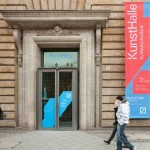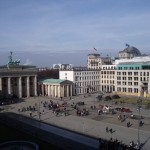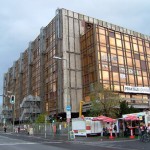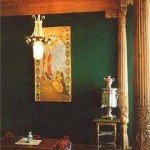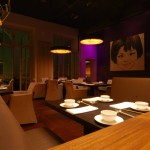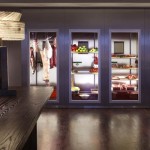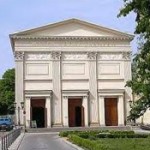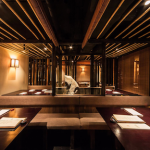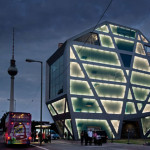シンケル・パビリオンSchinkel Pavillon
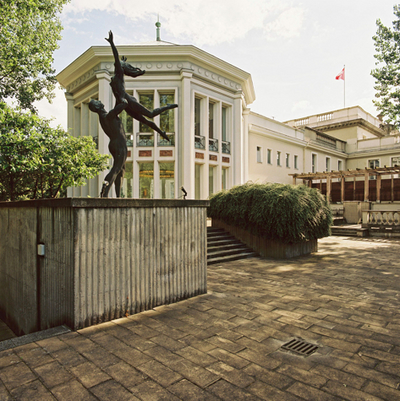
Photo: Thorsten Klapsch
Berlin has many galleries and museums with beautiful exhibit areas. The old and new museums on the Museum Island, chosen as World Heritage Sites, are a good example. On the other handベルリンには多くの美しい展示空間を持ったギャラリーや美術館などの美術施設がある。世界遺産にも選ばれている博物館島の旧博物館や新博物館などはその代表例と言えるだろう。一方規模が小さいとはいえ私設のスペースであるシンケル・パビリオンの存在を忘れてはいけない。博物館島など無数の名立たる建築が集まるベルリン中心部で、それらに埋もれること無く異彩を放つシンケル・パビリオン。その美しい建築空間では現代美術の作品が展示されている。
![]()
ベルリンの中心部にはウンター・デン・リンデンという大通りがある。通りはかつてベルリン王宮があった博物館島からブランデンブルク門までを結ぶ昔からの目抜き通りだ。通りに並ぶのはドイツ歴史博物館(旧武器庫)、ノイエ・ヴァッヘ(旧衛兵所)、フンボルト大学、ベルリン国立図書館など。それらは過去の街の姿を今に伝えてくれる。このような大通りを脇道にそれて少し進むと、シンケル・パビリオンが見えてくる。通りからは際立った特徴が無いように見えるが、ひとたび展示室に入ると驚くに違いない。作品だけでなくベルリンの風景が眼に飛び込んでくるからだ。八角形の形をした展示室は入り口部分を除く残り7面がガラス窓で覆われており、屋外からの光と風景が来場者を包み込む。そのため展示室は小さな空間にも関わらず、ベルリンの風景を取り込んだ圧倒的な広がりを生み出しているのだ。
![]()
シンケル・パビリオンの名前は19世紀のドイツ人建築家カルル・フリードリッヒ・シンケルに由来している。彼は当時の王室に仕えベルリン中心部の都市計画を担い、ノイエ・ヴァッヘや旧博物館といったギリシア建築に影響を受けた荘厳な建築物を多く生み出した。実際のところシンケル・パビリオンの建物はシンケルでなく建築家リチャード・パウリックによって1969年に建てられたもの。だが歴史的な景観に馴染むように建てられており、そこには取り壊されたシンケル建築の一部分が取り込まれている。また展示室のガラス窓には隣接するシンケルによって設計された教会が大きく写り込むため、建物が持つシンケルとの繋がりや、彼が生み出したベルリンの景観との繋がりを強く意識させられるだろう。
![]()
シンケル・パビリオンが現代美術作品を展示するスペースとして始動したのは2007年のこと。立ち上げたのはアーティストでもあるニナ・ポール。彼女はシンケル・パビリオンの運営だけでなく、展覧会のアーティストなどを決めるキュレーションも行っている。スペースはギャラリーのように作品販売を専門としておらず、展覧会の入場料を取っていないため、運営資金の多くをドイツで良く見られるクンスト・フェアアイン(美術協会)形式で得ている。それは一般の人々が協会(ここでの協会はシンケル・パビリオン)のメンバーとなり、年会費を支払うことで協会の企画運営を助けるもの。そのためギャラリーにありがちな作品販売に重きをおいた商業主義一辺倒の展示や、美術館でありがちな入場料収入を狙った来場者を増やすための通俗的な展示をここで見ることはない。見ることができるのは非常に質の高い展示なのだ。
![]()
今までシンケル・パビリオンで展示を行ったのは、ヨーン・ボック、クリスチャン・ヤンコフスキー、イザ・ゲンツケンなど国際的に活躍するアーティストたち。ガラス張りの小さな一室での展示となるため、空間を利用したインスタレーション作品や彫刻作品を見せるアーティストが多く登場している。スコットランド人アーティスト、カーラ・ブラックはその最たる例だろう。彼女は無駄無くデザインされた展示スペースの中心に、今にも壊れそうな歪んだセロファン製の巨大なリングを設置した。天井の照明に合わせて形作られた作品は、完全性を追求した空間に対して、脆さや形のくずれた様を美しく際立たせる。彼女はこの完成された空間に変化を持ち込み、作品と空間との共鳴を生み出すことに成功していた。
![]()
シンケル・パビリオンに訪れた者誰もが気付くに違いない。この展示空間の魅力はベルリンの街との繋がりが生み出していることを。展示室の窓にはベルリンの街並が広がっている。かつての東ドイツのシンボル的な存在だったベルリンのテレビ塔や、東ドイツ時代に撤去されたベルリン王宮の再建現場も見える。一方で古い建物を破壊して新しいモダンな建物にする建設現場も見える。つまり、ここからは過去と現在が混じり合う場を一望できるのだ。このような圧倒的な空間はアーティストを魅了すると同時に彼らの前に立ちはだかる。時として作品の良さを押し殺すまでに展示空間は美しいのだ。それゆえ、アーティストはベルリンの街や建築空間とのせめぎ合いを繰り広げる。そう、ここでは共鳴ともいえるその素晴らしいせめぎ合いに立ち会うことができるのだ。
![]()
Schinkel Pavillon
住所:Oberwallstraße 1, 10117 Berlin
開館時間:12:00〜18:00(月・火・水曜日休館)
TEL:+49 30 2088 6444
info@schinkelpavillon.de
http://www.schinkelpavillon.de
![]()
Text: Kiyohide Hayashi, though its scale is much smaller, we should not forget the private space, Schinkel Pavillon. While it is in the middle of Berlin, where famous architecture is plentiful, Schinkel Pavillon stands out prominently and shows contemporary art inside of its beautiful space.
![]()
For a long time Unter den Linden, a major street in the heart of Berlin, has connected the Museum Island, where the Berliner Stadtschloss used to be, and the Brandenburg Gate. The buildings on the street give a present-day glimpse in to the old appearance of the town, such as the German History Museum which used to be a weapons’ storage facility, Neue Wache which was once a guard station, the Humboldt University of Berlin and the Berlin Library. Off a short side street the Schinkel Pavillon appears. There is nothing particularly unique about the outside of the building, however, once people enter the exhibition hall they will be amazed because of not only the art pieces, but also through the scenery of Berlin coming into their eyes. All sides of the octagonal room, sans the entrance, are made up of glass windows so that the sunlight and an outside view can welcome visitors. Although the exhibit room is a small space, Berlin’s scenery seen through the window gives the room a large appearance.
![]()
The name of Schinkel Pavillon came from the 19th century German architect, Karl Friedrich Schinkel. He was serving the royal family at the time and took care of the city planning for the middle of Berlin. He created many solemn buildings influenced by Greek architecture, such as Neue Wache and the old museums. Schinkel Pavillon’s building was actually built by Richard Paurick in 1969. However, Richard included the ruins of Schinkel’s architecture in his design in order to give the building a historical look. Also, the church next door had been designed by Schinkel, and its huge appearance through the glass windows makes a strong connection between the building, Schinkel, and the sights in Berlin which he created.
![]()
In 2007, artist Nina Pohl started organizing contemporary art exhibits at Schinkel Pavillon. She is in charge of managing the space and curating art shows. Since this space is not focused on earning money by selling art or taking admission fees, their funds are raised by a Kunstverein system, wherein the public can become members of Schinkel Pavillon and pay an annual fee to support the organization. Therefore, unlike galleries with commercial art exhibits and museums which must have popular exhibits to increase the numbers of paid visitors, Schinkel Pavillon provides very high quality exhibits.
![]()
Artists who have done shows at Shinkel Pavillon include John Bock, Christian Jankowski and Isa Genzken, all internationally active artists. Many artists have shown installation and sculpture pieces that utilize the space, since exhibits are held in the small glass-walled room. One fine example is Scottish artist, Karla Black, who positioned a huge, fragile-looking cellophane ring in the middle of the exhibit space. This piece was designed to to be complemented by the ceiling light, and emphasized the beauty of fragilities and shapelessness when contrasted against a space in the pursuit of perfection. She brought change to this perfect space and succeeded in creating art that resonated in the space.
![]()
Everyone who has visited Schinkel Pavillon must have notice that the attraction of the exhibit space is the birth place of the connection with Berlin. From the exhibit hall’s windows observers can see Berlin’s TV tower, which used to be a symbol of East Germany, and the reconstruction site of the Berliner Stadtschloss, which was removed while part of East Germany. The construction sites where old buildings collapse and are rebuilt as new modern buildings can also be seen. After all, one can fully view places where past and present are mixed. Such overwhelming space attracts artists, though it also conflicts them. Sometimes, exhibit spaces could be too beautiful to conceal advantages of pieces. Therefore, artists develop conflicts with the town of Berlin and/or architecture spaces which is called resonance.
![]()
Schinkel Pavillon
Address: Oberwallstraße 1, 10117 Berlin
Opening Hours: 12:00 – 18:00
Closed on Monday, Tuesday and Wednesday
Tel: +49 30 2088 6444
info@schinkelpavillon.de
http://www.schinkelpavillon.de
![]()
Text: Kiyohide Hayashi
Translation: Yumiko Miyagawa
